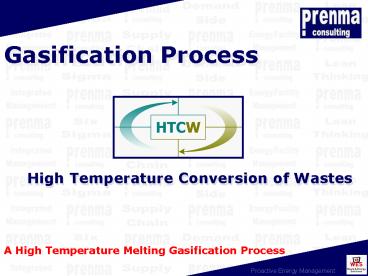Gasification Process PowerPoint PPT Presentation
1 / 14
Title: Gasification Process
1
Gasification Process
- High Temperature Conversion of Wastes
A High Temperature Melting Gasification Process
2
The process
Based on the economic cycle of material, the
waste treatment installations must respect the
following principles
- Reduction of volume and mass of the waste
- Elimination of potentially dangerous elements
- Energetic valorisation and material recycling
3
Elimination of wastes by their valorisation
The process
Classical processes
- Disposal of wastes
- Conventional incineration and treatment of
subsequent generated products - Process with partial valorisation of the material
contained in the wastes
The reactor with high temperature fusion
- Elimination of wastes by optimal valorisation of
material and contained energy - Simultaneous valorisation of energy and generated
material - The only material potentially containing damaging
elements the concentrations of components coming
from the washing of the gases are by far below
the 5 level
4
The process
Pilot Testing Station
Germany
- Flow of 1.500 kg/h or equally max. 10.000 t/y
- Result of an industrial study
- Proven technology and tested successfully in
industrial configuration - The concept covers the industrial needs for flows
in a range between 5.000 to 100.000 t/y
5
The process
Overview of the high temperature fusing
gasification process
Additives
WASTES
Installation of dosagefor continuous feedingof
the reactor
Fusion Reactorwith controlled pyrolisis zoneand
is high temperatures
Oxygen
Slag
Combustion Gas
Metal alloys
6
(No Transcript)
7
The Process
Products for neutralisation
Dry filter
Active coal
cokes
limestone
Conditioning the gas
Drying the gas
Combustion gas
Installation of dosage
Reactor for high temperature fusion
Residues of gas treatment
dosage
Residue to be evacuated
Back to the reactor
Preparation of wastes
metals
slag
oxygen
8
The process
No particular quality criteria are needed to the
waste (reduction, water content)No separation is
needed
waste
Mechanical and biological preparation of the
waste (dry stabilisation)
- Fuel based on waste - Mechanical preparation of
the wastes (rubbish, tyres) - Waste of commercial
and industrial origin - Special waste (medical,
biological, )
Additive material
- additives in function of the fuel type for
control of the reaction phases, e.g. limestone,
coke or used tyres.
Furnace material
9
The process
Feeding
- Material feeding with automatic operating
equipments - Controlled through fill-out checking
- Sorting out not required, minimum pre-treatment
- Metals and mineral substances mixing is desirable
- Water content up to 30 without problem (60-80
possible) - Process parameters optimisation through additives
(coke, limestone)
The feeding
10
The process
Process of pyrolisis(chemical decompositions
under high temperature)
The reactor
- No combustion and hence no subsequent undesired
products such as ashes, smoke or impure mixtures
of ashes and smokes - Higher efficiency of the gasification (75 80 )
Process
- Introduction of all the gases in the higher
temperature zones - Thermal transformation of the pyrolisis gas and
of the products under 2000 C and added oxygen - reduction of combustion products decomposition
into their basic materials (CO, CO2, H2, H2O) - Gas aspiration and conditioning into usable
combustion gas
The reactor
11
The process
Combustion gas
- Extraction out of organic substances
- Energy vectors of high value in a synthetic
quality (CO, H2) - Min. 2,3 kWh of energy recovery per average kg of
household waste - Usage in mechanical and thermal energy
Slag
- Extraction out of mineral substances
- Completely vitrified and hence almost completely
free of heavy metals - Possible usage as construction material such as
dams and ballast
Metal alloys
- Extraction out of metallic substances and heavy
- metals
- Mixture of melted metals
- Usage in the metallurgy for steel production
The products
12
Success factors
The process
Environmental impact
- High yield factor of the process
- Almost complete valorisation of the waste with
minimal residue - Products with respect of the environment I.e.
Good conditions for authorisations and positive
acceptance by the population
Costs
- Lower investment costs than with conventional
processes - Lower operational costs in combination with lower
nominal capacities
Capacities
- Can be variable due to reactors in cascade I.e
lower economical risks
Choice of operational site
- Multiple possibilities for instalment (in
agglomeration, industrial or commercial zone) - Simple integration into existing structure
Advantages for the customer
- Reducing the tendency of widespread of wastes
due to limitations of disposal capacities - Valorisation of energy produced via European
legislation on renewable energy - The obligation to fulfil standards and
legislation that are highly demanding in terms of
environmental protection
13
Factors for creating value
Operation of the installation generates the
following values
- Valorisation of waste(households, commercial and
industrial waste, special waste, various
residue) - Valorisation of gas of synthesis(production of
Methanol and energy) - Valorisation of heat(district heating or steam
distribution network) - Valorisation of metals(conditioning of melted
metals for metal production) - Valorisation of slag(conditioning of
sub-products such as granulates for filling
material)
14
Don't hesitate to contact us
Thank you
prenma consulting Proactive Energy Management SPRL
for
Clos Joseph Hanse, 10 1170 Brussels Belgium
your
More concept details are available by opening
our webpage at the index INFO Click on the
picture to open !
kind
32 2 675 66 89
Info_at_pr-en-ma.com
attention
www.pr-en-ma.com

